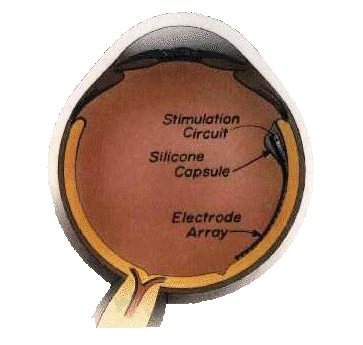

The Retinal Implant Project began in 1989 as a Massachusetts Eye and Ear Infirmary/Harvard Medical School and Massachusetts Institute of Technology collaboration. The project seeks to develop a silicon chip eye implant that can restore vision for patients suffering from Retinitis Pigmentosa and Macular Degeneration.
Age-related Macular Degeneration affects nearly 700,000 Americans yearly and is the leading cause of blindness. This central loss of vision often makes it difficult to impossible to perform detailed work such as reading. Retinitis Pigmentosa ranks number one in the world as a genetic form of blindness, denying approximately 1.2 million people sight. Peripheral vision goes flat followed by gradual loss of central or reading vision.
Blindness can result from corneal diseases, cataracts or diseases affecting the retina, optic nerve or brain. Retina diseases such as Macular Degeneration and Retinitis Pigmentosa involve only the rods and cones while cells that connect the eye to the brain remain healthy.
The chip under design will rest on the inside surface of the retina, opposite the damaged rods and cones and in contact with the relay cells to the brain. The use of an implant to bypass the damaged rods and cones is an approach that mirrors the way the renowned cochlear implant project has restored hearing to deaf patients. The implant will contain two silicon chips, both within the "silicone capsule." The top chip will receive light entering the eye, initially from a tiny laser affixed to a pair of glasses. A small CCD camera will also reside on the glasses to convert the visual scene to a series of laser pulses that will invisibly carry power and visual signals into the eye. The second chip, the circuit chip, will decode the laser's visual information, much as a TV set decodes the airwave signal. The visual signal will be sent to an "electrode array" that will transmit electric pulses to the eye's nerve cells.